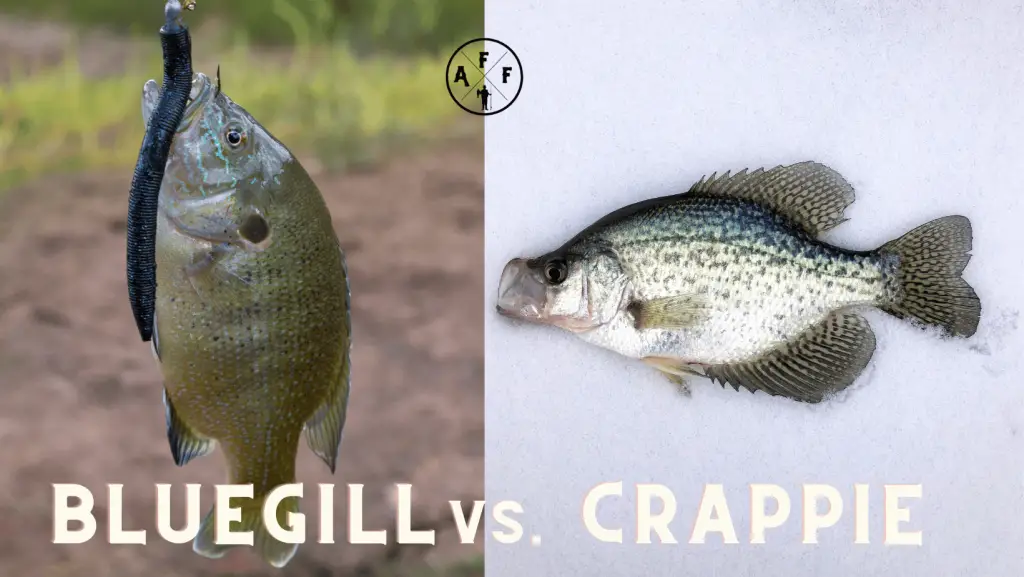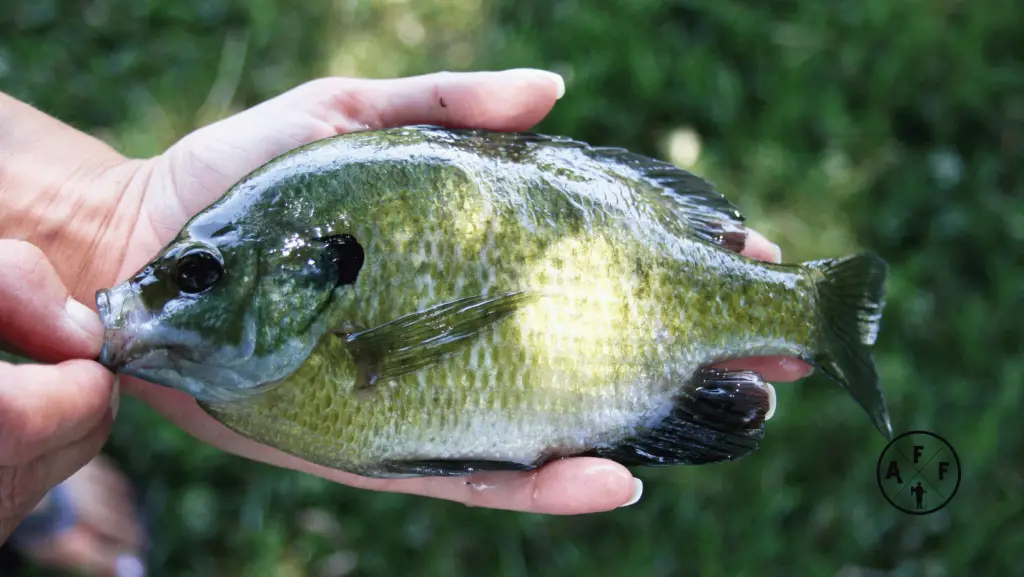
Crappie vs. Bluegill – what’s the difference?
Both Crappie and Bluegill are among my favorite freshwater fish to target, but they are often mistaken for one another among anglers.
In this post, I will go over the differences that I have discovered over the years between Bluegill and Crappie. These differences include appearance, habitats, feeding times, taste, size, and tactics for catching them.
If you’re looking to catch Crappie and Bluegill, it’s essential to understand these key differences. So keep reading to discover how to tell the difference between Crappie and Bluegill.
Critical Differences Between Crappie and Bluegill
The first question I get from friends and folks at the docks is how to tell the difference between Crappie and Bluegill. People want to know what they catch, and I don’t blame them.
Below are the main differences between these two freshwater fish, starting with appearance.
Crappie Vs. Bluegill Appearance
Color
Crappie is generally much darker, with a deep black or green hue. Bluegill colors, on the other hand, have a lighter greyish-green tone.
Dorsal Fins
Crappie has 7 or 8 spines on their dorsal fins, while Bluegills, on the other hand, usually have 10 or 11.
Using a dorsal fin for fish identification is one of the most reliable ways to distinguish different species.
Shape
When compared to Crappie, Bluegill are more rounded and have pronounced sides. On the other hand, Crappie tend to mimic a football shape with their long and slender bodies.
Markings
Growing up, my Uncle Jack taught me to identify fish and specifically the gender of fish by using markings. This is an effective method for distinguishing Bluegill vs. Crappie along with genders.
Male Bluegill has dark spots, with a green body and yellow breasts.
Female Bluegill have vertical bands of color with a greenish body.
There are many species of Crappie, so I will share my thoughts on the ones I have commonly caught myself.
Black Crappie have consistent rows of dark spots throughout their gray body.
White Crappie have vertical lines throughout their body with a much lighter colored body consisting of grey and white tones.
Eyes
Crappie typically have bigger eyes than Bluegill, aiding them in finding food in deeper waters.
Size
These panfish stay relatively small, with Crappie being larger than Bluegill.
Large Crappie can grow up to 16 inches long and weigh up to 3 pounds! Bluegill typically stays between 4 and 12 inches long and rarely weighs more than 1 pound.
Crappie Vs. Bluegill Habitats
These two panfish are found in the same habitats, although they prefer different areas of the same lakes, rivers, streams, and ponds.
When fishing in freshwater and distinguishing who is going after what, it’s easy to tell which anglers are going after Crappie and which are targeting Bluegill.
Crappie are found around structures. Whether it is submerged branches, trees, bridge pilings, docks, or any other structure, this is where you want to fish for Crappie. Along with structure, Crappie prefer deeper water than Bluegill, especially in the summer when water temperatures peak.
Bluegill are found along banks. Whether it is a grass bank or mud bank, Bluegill tend to stay tight to the edge of whichever body of water they are in. They are also found in more shallow water compared to Crappie. I catch most of my Bluegill in around 5′ of water.
Crappie Vs. Bluegill Feeding Times
Crappie and Bluegill also have different feeding times. Crappie tend to feed at dawn and dusk, so I usually plan my fishing trips when targeting Crappie.
Bluegill, however, can be found actively foraging most of the day. I have caught more Bluegill during the middle of the day compared to Crappie.
Crappie vs. Bluegill Taste
Both Crappie and Bluegill are considered good table fare among freshwater anglers.
I, along with most anglers, prefer Crappie over Bluegill. Not just because of the flavor but because Crappie have much more meat than Bluegill. That said, Bluegill, while a smaller fish, also tastes good. A great option if you catch one closer to 1 pound, which is as big as they will get.
Crappie is considered one of the best-tasting freshwater fish for a good reason. They are soft and flaky with an almost sweet kind of taste. Overall they don’t have a robust flavor which is why I add a good bit of Old Bay seasoning to my Crappie filets.
Check out this page here for more info on Crappie recipes and what they taste like.
If you can land a larger Bluegill, you can make a dinner out of it. Plus, Bluegill are generally easier to catch than Crappie so combining a fewer smaller fish is always an option to round out a meal.
Bluegill taste sweeter than Crappie, which calls for less seasoning, as it naturally has more flavor, which some people, including me, don’t prefer. For more of my thoughts on Bluegill’s taste and recipes that I have used, check out this page here.
Fishing Techniques for Crappie and Bluegill
While both fish live in the same bodies of water, the best techniques for catching them are different. I’ll share my thoughts on tactics I have used and other tips to consider when fishing for Crappie and Bluegill.
Bluegill fishing

As I mentioned earlier, Bluegill are usually found closer to banks which means they are often around heavy cover and vegetation. Therefore I like to target areas that are heavily vegetated and have cover which is naturally along the edge of the body of water.
I use a 6’6″ fast action rod with a 2000 class spinning reel paired with a 4 lb. mono line for Bluegill.
I love to use a light jig head – around 1/32 oz. is my go-to, especially in shallow water where Bluegill prefer to feed. Pairing a lighter jig head with a slip bobber is also an option.
For bait, blood worms are the way to go. For half of the price, nightcrawlers will also serve you well.
Crappie fishing

As I mentioned earlier, the habitat for Crappie almost always consists of structure. So, heading straight for bridge pilings, docks, submerged trees, concrete piles, and other structures is a good action plan for Crappie fishing.
My rod and reel setup is very similar when fishing for Bluegill, aside from using live bait and a live bait hook.
My go-to live baits when fishing for crappies are shiners and wax worms. I have had just about equal success using both live baits.
When live bait is not an option, I always go right for Gulp Shrimp, made by Berkley. Every angler should have Gulp in their tackle box for when the bait store is sold out.
Common Questions Related to Crappie and Bluegill
When it comes to Crappie and Bluegill fishing, I have also asked many questions and received them. Below, I will answer some of the most common questions about these two panfish species.
Do Crappie eat Bluegill?
Yes, Crappie are known to eat Bluegill. However, Crappie tend to feed more on minnows, so if possible, target Crappie with live bait such as shiners and wax worms.
Is a crappie a panfish?
Yes, Crappie are considered panfish. Crappie and Bluegill are both part of the sunfish family, which is why they are often caught together in the same bodies of water.
Are Crappie the same as sunfish?
No, Crappie and sunfish are not the same. Crappie belongs to the sunfish family but is a separate fish species. Sunfish refers to all members of the sunfish family, which include Bluegill, Black Crappie, White Crappie, Green Sunfish, Spotted Sunfish, Redear Sunfish, Pumpkinseed Sunfish, Longear sunfish, and more.
Final Thoughts on Bluegill vs. Crappie

Crappie and Bluegill are two panfish species that can regularly be found together in the same bodies of water. While they have some similarities, such as size, shape, and habitats, they also have some essential differences that set them apart. Knowing these differences can help you land more fish as well as quickly identify these fish species.
For more guidance on both Bluegill and Crappie fishing, check out the pages below:










